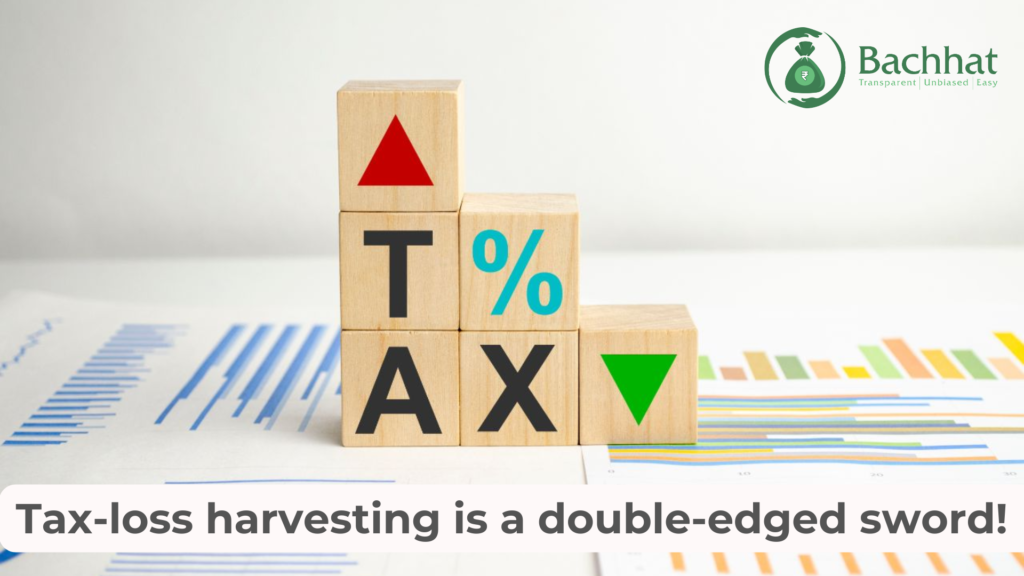
You must have read articles floating on the internet encouraging you to book a loss in your equity investments to set off against capital gains made in the past and thereby, reducing the tax liability. This strategy is popularly known as “tax-loss harvesting.”
While one can defer the tax liability with this strategy, it is important to know that it comes with inherent risks. If adequate precautions are not taken while using this strategy, you may end up paying more income tax than before. For example, you may end up paying more taxes if your long-term capital gains are less than Rs. 1,25,000.
Before we deep-dive into the risk associated with tax-loss harvesting and precautions to be taken, let us understand what tax-loss harvesting is.
What is Tax-loss harvesting and how it is a legal way to save capital gains tax
Assume that you have a short-term capital gain on equity shares of Rs. 4,00,000 during this year, on which you will pay tax @ 20% (assuming the sale is after 22nd July 2024). You have recently started an SIP in an equity mutual fund, and due to the current stock market correction, the SIP is at a loss of Rs 1,00,000.
You can sell the equity mutual fund, book the short-term loss and set off this loss against short-term capital gain from equity shares, reducing your tax liability. This is tax-loss harvesting – deferring your tax outgo to a later period.
Example of how tax-loss harvesting works:
Before Tax-loss Harvesting | After Tax-loss Harvesting | |
Short Term Capital Gain on Shares | 4,00,000 | 4,00,000 |
Short Term Capital Loss on equity MF | – | (1,00,000) |
Total Capital Gains | 4,00,000 | 3,00,000 |
Tax Liability (@ 20%) * | 80,000 | 60,000 |
Tax Savings | – | 20,000 |
*Education cess and surcharge to be added
As you can see, tax-loss harvesting helped you defer Rs 20,000 in taxes for the current year. You can purchase the same equity mutual fund the very next day to ensure you are on track for your investment journey.
Applicability of tax-loss harvesting
This stock market trick is not only restricted to short-term capital gains. You can also apply this if you have long-term capital gains. The table below lists the losses that can be set off against short-term as well as long-term capital gains.
Short Term Capital Loss | Long Term Capital Loss | |
Short Term Capital Gain | ✔️ | ✖️ |
Long Term Capital Gain | ✔️ | ✔️ |
If you have short-term capital loss, it can help you reduce your short-term as well as long-term capital gains. However, if you have long-term capital loss, it will help you reduce only long-term capital gain tax liability.
In case you have booked a loss, and you do not have any capital gains to set off against such a loss, there is no need to worry. The capital loss is allowed to carry forward to future years and can be set off against the capital gains (in line with the above table) for the subsequent 8 years.
What you can lose due to Tax-loss harvesting:
Any tax-saving strategy has in-built risks. Tax-loss harvesting also comes with its own set of risks, which one should be aware of. Here is an example to understand how tax-loss harvesting is a double-edged sword when your long-term capital gain is Rs 1,25,000 or less.
Year 1:
(a) An investor has a long-term capital gain of Rs 1,25,000 on XYZ shares.
(b) The investor takes advantage of the tax-loss harvesting strategy and sells another share (ABC)
at a loss of Rs 1,25,000 (Purchase Price – Rs 2,50,000 and Selling Price – Rs. 1,25,000)
(c) Next day, the Investor purchase the same shares (ABC) at Rs. 1,25,000.
Year 2 or later:
(a) The Investor sells ABC Shares at Rs. 4,00,000.
For ease of calculations, we have assumed that all transactions qualify for long-term capital gain
tax benefits.
If Tax Loss Harvesting Strategy is not used | If Tax Loss Harvesting Strategy is used | |
YEAR 1 | ||
Long Term Capital Gains on XYZ shares | 1,25,000 | 1,25,000 |
Long Term Capital Loss on ABC shares | 0 | 1,25,000 |
Net Long Term Capital Gains | 1,25,000 | 0 |
Less: Long Term Capital Gain exemption (Actual gain or Rs 1,25,000 whichever is lower) | 1,25,000 | 0 |
Taxable Long Term Capital Gains (Year 1) | 0 | 0 |
Tax Liability (Year 1) | 0 | 0 |
YEAR 2 OR LATER | ||
Sale Price of ABC Shares | 4,00,000 | 4,00,000 |
Purchase Price of ABC Shares | 2,50,000 | 1,25,000 |
Long Term Capital Gain on ABC shares | 1,50,000 | 2,75,000 |
Less: Long Term Capital Gain exemption (Actual gain or Rs 1,25,000 whichever is lower) | 1,25,000 | 1,25,000 |
Taxable Long Term Capital Gains | 25,000 | 1,50,000 |
Tax Liability (Year 2 or later) | 3,125 | 18,750 |
Total Tax Liability (All Years) | 3,125 | 18,750 |
Additional Tax Paid | n.a. | 15,625 |
Notes:
- For the sake of simplicity, long-term capital gain tax rate of 5% is assumed for all transaction.
- The outcome does not change even if any of these assumptions are changed.
As can be seen from the above example, instead of reducing the tax outgo, the investor paid more taxes eventually by using tax loss harvesting.
Risks involved in using Tax-loss harvesting stargety
There are other scenarios to be factored in while considering tax-loss harvesting:
- Uncertainty of purchase price: Since you are purchasing the same investment again after selling it, there might be an instance of the market going up and the purchase price might be higher than the selling price. The uncertainty of purchase price can reduce or offset tax benefits from this strategy. This uncertainty can be negated by purchasing the share simultaneously in a different demat account or by purchasing the mutual fund in a different folio on the same day.
- Tax deferment and not tax saving strategy: Tax-loss harvesting is a tool to defer your tax liability and not to eliminate your tax liability. You will be required to pay higher taxes in the future since the purchase price of your new investment is lower.
- Transaction Costs: There are transaction costs involved (brokerage, stamp duty, etc) with any buy and sell transaction, which reduces the tax savings to that extent.
- Exit loads on selling: Be aware of the exit loads before selling a recently purchased mutual fund. For e.g.: Few equity funds levy an exit load of 1% if you sell them before a certain period (e.g. 90 days).
- Timely filing of return: To claim this benefit, it is important to file the income tax return on time. Any delay in the same, and you will not be entitled to claim the loss.
- Long-term asset turning into short-term asset: Capital gains on long-term equity are 12.5%, whereas for short-term equity are 20%. In case a long-term asset is sold to take advantage of tax loss harvesting, one needs to be careful not to sell that asset once purchased within a short-term period. Otherwise, there will be a higher tax incidence.
Bachhat’s Take:
While tax-loss harvesting is a perfectly legal way to defer your taxes, and savvy investors can use this strategy to defer their tax outgo. However, it comes with its own set of risks, and if adequate precautions are not taken, this may lead to an additional tax burden.
Have you used this strategy this year? If yes, were you aware of the above risks? We would like to hear your feedback.
By: Vishal Shah, SEBI Registered Investment Advisor and founder of Bachhat
March 28, 2025
Disclaimer: This is not a financial advice and the readers should reach out to registered investment advisors for any financial advice. Registration granted by SEBI, membership of BASL and certification from National Institute of Securities Markets (NISM) in no way guarantee performance of the intermediary or provide any assurance of returns to investors. Investment in securities market are subject to market risks. Read all the related documents carefully before investing.)
Read our blog for more such articles and insights on personal finance, investments, insurance, and taxes blog: Blogs

